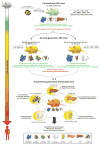The use of humanized mice for studies of viral pathogenesis and immunity
- PMID: 29604551
- PMCID: PMC5940492
- DOI: 10.1016/j.coviro.2018.03.003
The use of humanized mice for studies of viral pathogenesis and immunity
Abstract
Humanized mice, that is, animals engrafted with human tissues and/or expressing human genes, have been instrumental in improving our understanding of the pathogenesis and immunological processes that define some of the most challenging human-tropic viruses. In particular, mice engrafted with components of a human immune system (HIS) offer unprecedented opportunities for mechanistic studies of human immune responses to infection. Here, we provide a brief overview of the current panel of HIS mouse models available and cite recent examples of how such humanized animals have been used to study immune responses and pathogenesis elicited by human-tropic viruses. Finally, we will outline some of the challenges that lay ahead and strategies to improve and refine humanized mice with the goal of more accurately recapitulating human immune responses to viral infection.
Copyright © 2018 Elsevier B.V. All rights reserved.
Figures

Similar articles
-
The Application of Humanized Mouse Models for the Study of Human Exclusive Viruses.Methods Mol Biol. 2017;1656:1-56. doi: 10.1007/978-1-4939-7237-1_1. Methods Mol Biol. 2017. PMID: 28808960
-
New generation humanized mice for virus research: comparative aspects and future prospects.Virology. 2013 Jan 5;435(1):14-28. doi: 10.1016/j.virol.2012.10.007. Virology. 2013. PMID: 23217612 Free PMC article. Review.
-
A Hitchhiker's guide to humanized mice: new pathways to studying viral infections.Immunology. 2018 May;154(1):50-61. doi: 10.1111/imm.12906. Epub 2018 Mar 9. Immunology. 2018. PMID: 29446074 Free PMC article. Review.
-
Immune Ecosystem of Virus-Infected Host Tissues.Int J Mol Sci. 2018 May 6;19(5):1379. doi: 10.3390/ijms19051379. Int J Mol Sci. 2018. PMID: 29734779 Free PMC article. Review.
-
Subversion of the cellular autophagy pathway by viruses.Curr Top Microbiol Immunol. 2009;335:323-33. doi: 10.1007/978-3-642-00302-8_16. Curr Top Microbiol Immunol. 2009. PMID: 19802573 Review.
Cited by
-
A humanized "new-trophil" mouse to study early inflammatory processes.Proc Natl Acad Sci U S A. 2022 Dec 6;119(49):e2216699119. doi: 10.1073/pnas.2216699119. Epub 2022 Nov 29. Proc Natl Acad Sci U S A. 2022. PMID: 36442110 Free PMC article. No abstract available.
-
Mathematical modeling suggests that entry-inhibitor bulevirtide may interfere with hepatitis D virus clearance from circulation.J Hepatol. 2022 May;76(5):1229-1231. doi: 10.1016/j.jhep.2021.12.030. Epub 2022 Jan 5. J Hepatol. 2022. PMID: 34995688 Free PMC article. No abstract available.
-
Transcriptomic profiling reveals SARS-CoV-2-infected humanized MHC mice recapitulate human post vaccination immune responses.Front Cell Infect Microbiol. 2025 Aug 1;15:1634577. doi: 10.3389/fcimb.2025.1634577. eCollection 2025. Front Cell Infect Microbiol. 2025. PMID: 40822594 Free PMC article.
-
A virological view of tenascin-C in infection.Am J Physiol Cell Physiol. 2023 Jan 1;324(1):C1-C9. doi: 10.1152/ajpcell.00333.2022. Epub 2022 Dec 2. Am J Physiol Cell Physiol. 2023. PMID: 36458980 Free PMC article. Review.
-
Advanced model systems and tools for basic and translational human immunology.Genome Med. 2018 Sep 28;10(1):73. doi: 10.1186/s13073-018-0584-8. Genome Med. 2018. PMID: 30266097 Free PMC article. Review.
References
-
- Strowig T, Gurer C, Ploss A, Liu YF, Arrey F, Sashihara J, Koo G, Rice CM, Young JW, Chadburn A, et al. Priming of protective T cell responses against virus-induced tumors in mice with human immune system components. J Exp Med. 2009;206:1423–1434. First evidence priming of virus-specific, HLA-restricted CD8+ T cells in humanized mice. - PMC - PubMed
Publication types
MeSH terms
Grants and funding
LinkOut - more resources
Full Text Sources
Other Literature Sources
Medical

